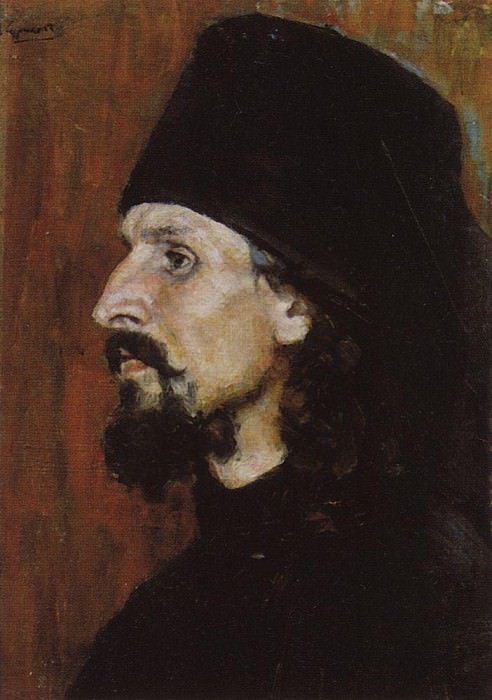Monk. 1900 e Vasily Ivanovich Surikov (1848-1916)
Vasily Ivanovich Surikov – Monk. 1900 e
Edit attribution
Download full size: 702×1000 px (0,1 Mb)
Painter: Vasily Ivanovich Surikov
Surikov was a Russian painter who came from a poor Cossack family. His great-grandfather is said to have been a man of immense strength who once pulled a heavy raft out of a river in a thunderstorm, which otherwise would have been swept away and broken. Surikov is famous for his historical paintings. "Boyarynya Morozova", "Suvorov’s crossing of the Alps" - he wrote with knowledge, with great attention to historical details, with a long search for prototypes for the main characters. Once an artist friend to whom he suggested looking at the unfinished "Boyarynya Morozova" advised him to cut off a strip of snow at the bottom, which was not necessary anyway.
Description of Vasily Surikov’s painting The Monk
Surikov was a Russian painter who came from a poor Cossack family. His great-grandfather is said to have been a man of immense strength who once pulled a heavy raft out of a river in a thunderstorm, which otherwise would have been swept away and broken. Surikov is famous for his historical paintings. "Boyarynya Morozova", "Suvorov’s crossing of the Alps" - he wrote with knowledge, with great attention to historical details, with a long search for prototypes for the main characters.
Once an artist friend to whom he suggested looking at the unfinished "Boyarynya Morozova" advised him to cut off a strip of snow at the bottom, which was not necessary anyway. To which Surikov replied - "I can’t. Then the sledge won’t go." His attention to detail was astounding, and his desire for historicism, to convey the depth of the Russian spirit, was felt in the portraits
"The Monk" is one of them. It depicts a middle-aged man in a monk’s garb in profile. His hair is curly, short goatee neatly trimmed in shreds, whiskers slightly drooping, look straight, open and studying. Like all portraits, it gives off a sense of the darkness of the ages.
It’s as if the viewer looking at the painting is looking into a monk’s cell of the mossy old days, in which a monk sits at a chronicle. His face is illuminated by the light from the window and, at the same time, by the light from within. He believes deeply, sincerely, but he is not stupid - just his faith is as firm as the ground on which his cell stands, high as the sky on which he looks in the morning.
The portrait encapsulates an entire life, conveyed in one person - a life of hard work, close to the earth, and lit from within by the desire for something more than just a potato harvest or apple trees. A life of strikes borne with humility, a life that is demanding and composed of self-denial. A life chosen voluntarily.
Кому понравилось
Пожалуйста, подождите
На эту операцию может потребоваться несколько секунд.
Информация появится в новом окне,
если открытие новых окон не запрещено в настройках вашего браузера.
You need to login
Для работы с коллекциями – пожалуйста, войдите в аккаунт (open in new window).




















COMMENTS: 1 Ответы
все отлично меня поразило
You cannot comment Why?
The artist employed visible brushstrokes to render the figure, lending a sense of immediacy and texture to the work. Light falls across the man’s face, highlighting the prominent brow ridge, the sharp angle of his nose, and the density of his beard. The eyes are directed towards an unseen point beyond the frame, conveying a contemplative or perhaps melancholic mood.
The limited palette – primarily blacks, browns, and ochres – contributes to the overall feeling of austerity and introspection. The heavy hood not only serves as a visual element but also symbolically suggests seclusion and spiritual dedication. The rough application of paint gives an impression of raw emotion and psychological depth.
Subtly, there is a sense of weariness or quiet suffering conveyed through the subject’s features. It isnt a depiction of joy or triumph, but rather one that hints at inner struggle and perhaps resignation. The lack of specific contextual clues allows for multiple interpretations; he could be viewed as representing faith, solitude, or simply the weight of existence.